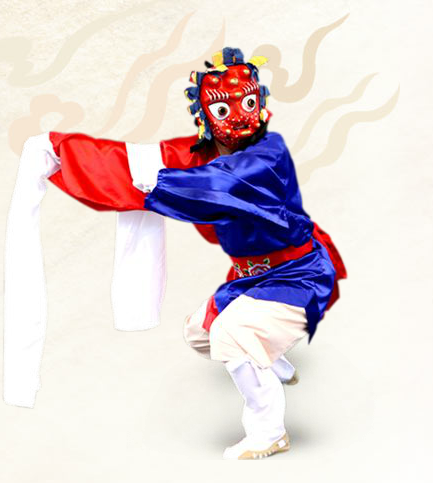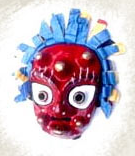|
Learning Korean Traditional Mask Dance - Bongsan Mask Dance

What is Bongsan Mask Dance?
The Bongsan Mask Dance Drama is a representative masque dance drama of Hwanghae Province, presently located in the North Korea, this was originally performed in Kyongsudae in Bongsan township. After around 1915, when the township administration office was moved to Sariwon, and the Seoul-Shinuiju Railroad was opened, it was performed at the foot of Mt. Kyongnam in Sariwon.
Originally, the play's primary function was religious; performances were held to commemorate the birthday of Buddha on the eighth day of the fourth lunar month. In the nineteenth century, the mask dance drama was incorporated into the magnificent folk festival held to celebrate Tano, the fifth day of the fifth lunar month. The Tano festival was held at a relatively slack point in the busy agricultural calendar, just before the arduous work of summer rice-planting begins. As part of festival, a performance of mask dance drama would be held to expel evil and invoke blessings for a good harvest in the coming year.
Like similar forms of Korean masque dance dramas such as the Yangju Byol Sandae Nori of the Seoul region and the Ogwangdae Nori(or "Five Clown's Play) of the southern part of Korea, the Bongsan Mask Dance Drama combines dialogue, dance, mime and music. It is unique, however, in the use of quotations from the classical poetry. Interspersed with prose dialogue, the poetry is chanted to drum rhythms.
The main themes of the Bongsan Mask Dance Drama are evident in three kinds of dramatic actions; satire involving degenerate monks, mockery of aristocrats and the portrayal of the daily life of the common people. The Bongsan Mask Dance Drama employs the samhyon-yukkak ,or six musical instruments ensemble; two piri(oboe-like musical instrument), one jottae(bamboo transverse flute), one haegum( two-stringed fiddle), and janggo(hourglass-shaped drum), the buk(barrel drum), and the kkwaenggwari(small gong). These instruments produce the accompanying dance rhythms; yombul( a six-beat rhythmic pattern), taryong(a twelve-beat pattern with the accent on the ninth beat) and gutkori(also a twelve-beat pattern).
Sawi (various dance movements) utilized in the Bongsan Mask Dance Drama are oe-sawi(hand circles the head once), and kop-sawi(hand circles across the front of the head first and then circles behind in the opposite direction). Kkaekki chum, or dance (hand circles head once, then holding right hand on shoulder left hand waves a willow branch up and down) is characteristic of Chwibari's dance. Malttugi chum in the tuo chum pattern(he waves a riding crop around in front of him, circles it over his head in the opposite direction, and then holds it in front of him with both hands on the handle , then wield's the riding crop to drive the aristocrats into the pigsty) and Miyal dances in kungdungi chum(swayng hips motion). Distinct walking patterns are also used by the various characters. For example, Chwibari's kodurum(strutting motion) and Miyal's kaljija-kolum(zig-zag walking motion)
The Second Episode : The Eight Buddhist Monks

The Bongsan Mask Dance Drama is divided into seven episodes as follows:
1. Ceremonial Opening Dance by the Four Young Monks
2. The Eight Buddhist Monks
3. Dance and Songs by Sadang and Kosa
4. The Old Priest's Dance
Scene 1 : The Old Priest and the Young Shaman
Scene 2 : The Shoe Seller
Scene 3 : The Prodigal
5. The Lion Dance
6. The Noblemen and their servant
7. The Old Couple
The second episode :
Instead of practicing asceticism according to the calling of the Buddhist doctrine, the Eight Monks prefer to engage in dancing and singing. One by one, each enters the stage and recites an ancient poetry in time with the music, whereupon they dance setting in 12/8 meter called kkaeki-chum that is quite lively, dancing around the performance area. Each one's poetry and dance has its own special characteristics. At the end, all eight monks join together in a dance that is light and nimble.
http://www.bongsantal.com/index.html

Click the image to see the video
|